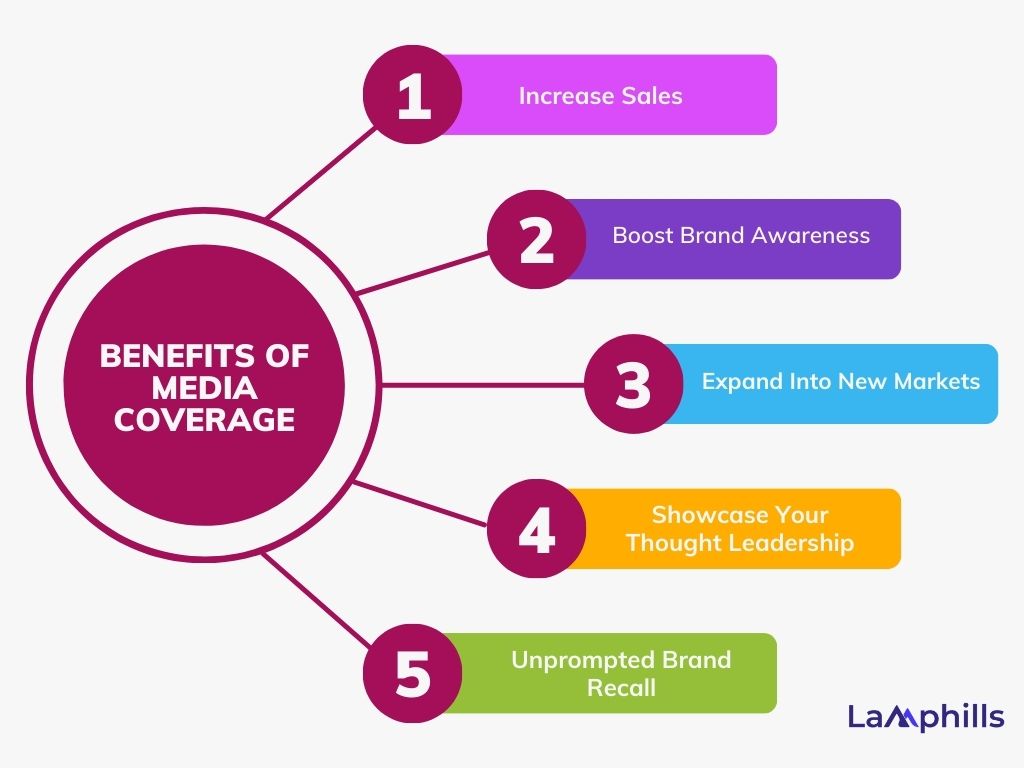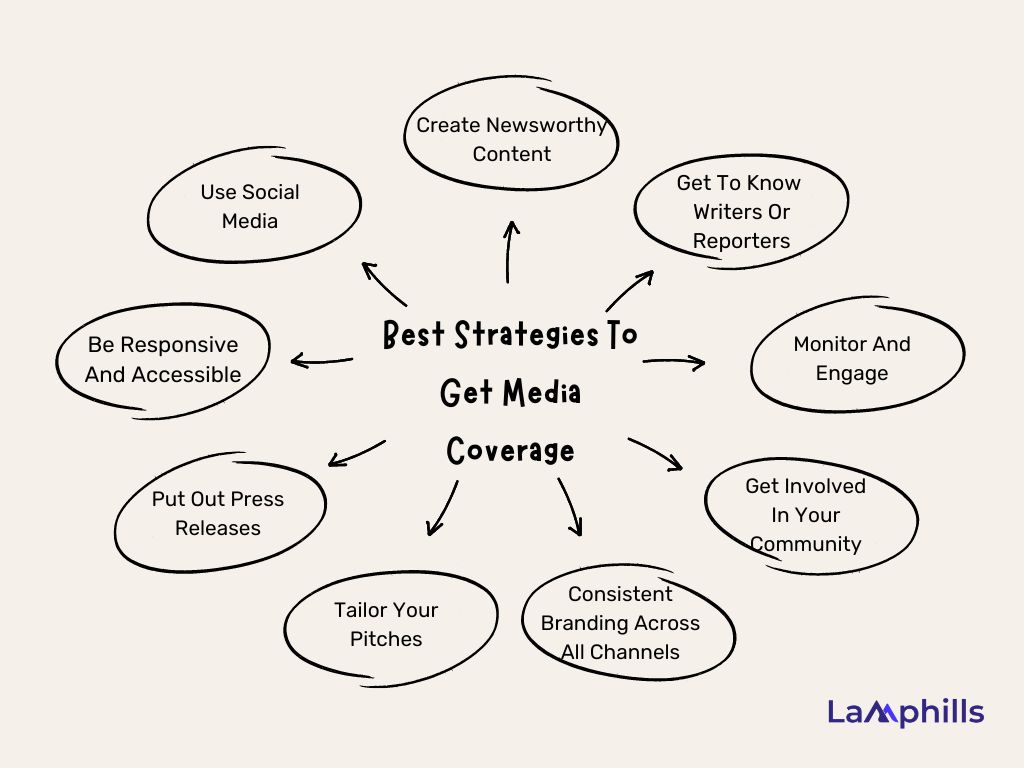In the realm of public relations, advertising, marketing, and other related fields, media coverage plays a crucial role. The primary goal is to reach a certain audience and impact their perceptions or behavior. It may be used for a variety of goals, including marketing a new product, influencing public opinion, and informing the public about pressing topics.
Media coverage is crucial as it amplifies the message and reaches a wider audience. It helps in brand building, increases visibility, and boosts credibility.
Key Points
- Media coverage is any time a news outlet or publication writes a story about your business or includes you in some way.
- There are three types of media in marketing – paid, earned, and owned media.
- Positive media coverage gives you the chance to convey your strengths and expertise.
- It can increase brand awareness, enhance reputation, generate leads, and increase sales.
- While it can be challenging to deal with negative media coverage, it’s essential to respond effectively to mitigate potential damage to your reputation.
Understanding The Concept Of Media Coverage
Media coverage, in a nutshell, is gaining exposure in print, radio, press, or other media. It is any time a news outlet or publication writes a story about your business or includes you in some way.
In most cases, this could be about something excellent you’re doing in the community or how you’re working to change your industry in some way. It might even include using you as an expert in your field to answer a commonly asked question or an issue your target audience is currently facing.
Unfortunately, this can also be good press or bad press — depending on the situation.
Media coverage can increase brand awareness, enhance reputation, generate leads, drive traffic to a website, and increase sales. It also provides third-party validation, which can enhance credibility.
The effectiveness of media coverage may be judged in a variety of ways. This includes the volume of coverage (number of articles or airtime), the prominence of the coverage (first-page story or prime-time news), and the tone of the coverage (positive, negative, or neutral).
Types Of Media In Marketing
There are three types of media in marketing – paid, earned, and owned media. Each type serves a specific purpose, and they all combine to make up your brand’s entire content strategy.
Understanding where each type of media fits in the sales funnel helps you build a well-rounded digital presence.
#1. Earned Media
This is the organic response your brand gets from other sources. It is content that other people and publishers produce about your company. This includes reviews, social media shares, press about your brand, and more. It is most effective at the top of the funnel when a potential customer is first engaging with your brand.
There are different ways to invest in earned media. You can offer incentives to customers who leave reviews, run contests and giveaways to generate social shares or build relationships with media sources in your industry.
Local Consumer Review reports that 77% of consumers read online reviews for businesses in their area. Hence, earned media is a great approach to boost your reputation and give leads a good first impression of your brand.
#2. Paid Media
Paid media is that part of marketing and advertising that requires the purchase of ad space to promote a brand to larger audiences. Brands pay for content promotion to spread their message to audiences, at scale. This includes any advertising space you pay for. The most common channels for paid campaigns are social media and search engines. However, ads can be run on other platforms like Gmail, which appear in a user’s inbox.
Paid media can be used to increase awareness at the top of the funnel or encourage sales toward the bottom. It offers immediate, guaranteed access to new audiences and can also be targeted to users who indicate purchase intent.
Paid media is part of a brand’s strategy to increase traffic, sales, and conversions through clicks, and ultimately increase revenue. However, it can be risky — especially if you run campaigns without a good strategy. If your ad doesn’t generate results, it’s simply a waste of money since your target audience isn’t seeing what you paid for.
#3. Owned Media
This is content that your brand owns and produces. Blog posts and social media posts are examples of owned media. Case studies, PDFs, and product demos can also be effective as owned media.
Most users who come to your owned channels already know about your brand or are interested in learning more about your product or solution. So, owned media is often more relevant to customers in the middle of the sales funnel.
This type of content is vital for generating organic traffic and overall engagement. It’s designed to give your audience a deeper look at your products or services, so they can build confidence in your brand and eventually become loyal customers.
Benefits of Media Coverage
Positive media coverage should be an integral part of any marketing strategy. It gives you the chance to convey your strengths and expertise and can turn customers and stakeholders into brand advocates, as they see how well you’re doing. It also comes from a third-party source, making it more convincing and more credible in the eyes of the reader.
Media coverage highlighting your position in the market as a critical thought leader can increase sales.
Here are some reasons why media coverage is essential:

#1. Increase Sales
Through media coverage, you can influence consumer buying behavior. Highlighting product features in the media can also demonstrate the strength of your brand. With more brand awareness comes more sales.
#2. Boost Brand Awareness
Limiting your marketing to your website or other owned media means you will likely only engage those who already know what you do. Getting media coverage will expose your brand to a larger audience than you would otherwise have reached. Media coverage can help you reach interested people to learn more about your product.
#3. Expand Into New Markets
Picture this. Your startup has successfully grown, and you’ve enjoyed success in your primary market. You are now looking seriously at expanding into new territories. As you know by now, you have a better chance of getting people interested in your product or service if they see you in the news or read about you first. You can reach new markets and grow your business more quickly than your competitors through media coverage.
It is also a great way to differentiate you from the competition as you chase similar audiences for market share.
#4. Showcase Your Thought Leadership
Thought leadership refers to sharing your opinions with audiences keen to hear what you say on a topic and who may take something away from it.
For this reason, media coverage is vital, as it spreads your insights to a wider audience and expands your professional network. It helps you become instantly recognized whenever a new discussion point affects your industry, increasing the positive media coverage about you and promoting the organization as a credible source with something valuable to offer.
#5. Unprompted Brand Recall
What comes to mind if you were asked to name a famous technology company? If you were to survey 100 people on the street, you would probably hear the same few brands.
This question, when asked to customers, is called unprompted brand recall. The more likely a customer remembers your brand, the higher the recall, and the more successful the brand is. Maintaining media coverage helps increase the customer’s ability to name your brand when asked about a specific industry.
How To Measure & Analyze Media Coverage
Traditionally, Advertising Value Equivalency (AVE) was used to measure the amount of space a piece of content occupied, compared with the cost of an equivalent paid advertisement which was a common way to analyze media coverage.
While this may have been the best way to demonstrate value in the past, it doesn’t have the same efficacy today. This is partly due to the differences between PR and advertising today. AVE also fails to account for the tone of media coverage, who has seen the coverage, or the digital impact of that coverage in the world of social media. Traditional advertising is also no longer the focus for many brands, who instead focus on influencer marketing, paid social advertising, or web-based pay-per-click style ads.
Despite this, a UK study showed that 35% of agencies still use it. For many, AVE is useful as the only form of measurement that attributes a monetary value to content. However, due to the restrictions mentioned above, this must be used in conjunction with newer, more digital-focused methods of measurement to give a fuller picture.
Hence, if your job is to put together a media coverage report, you should cover the following:
Measuring media coverage
Best Strategies To Get Media Coverage
Now that we’ve discussed the reasons why you would want to include press and media coverage as part of your overall marketing plan, let’s look at a few ways you can make this happen:

#1. Create Newsworthy Content
One of the easiest ways to get press coverage for your business is to create newsworthy content. By this, I mean covering topics that are timely and that members of the audience or readers could relate to.
You can then submit this information to certain news outlets.
In some cases, this might land you a free guest post spot. Others could charge you a small fee for paid publication, but the benefits are usually worth it.
To come up with topics that are likely to get noticed, take extra time to really think about the needs of your target market and what they would ask a professional in your industry. You can even put together a buyer persona if it makes it easier to create stellar written or video content for your brand.
#2. Use Social Media
These days, the news cycle moves incredibly fast. If you have an idea for a story that is timely or could chime in on a topic that you understand professionally, look to social media pages for news outlets or magazines.
Often, they’re posting the need to talk to someone to complete a story. If you can pounce on this type of request quickly enough, your business can be the one to get a free press coverage.
Likewise, look for the comment section about newsworthy topics and the individual Facebook pages of certain writers or media personalities. More requests are sometimes hidden there, too.
#3. Get To Know Specific Writers Or Reporters
Sometimes press coverage isn’t about what you know — it’s who you know. Hence, finding out who covers topics like those related to your industry or local community is a good way to increase the chances of getting your business included in a story.
You can send a message to these people and offer a story pitch. Or just give them your contact information in case there’s additional information you can assist with.
There’s also a website called Help a Reporter Out (HARO). This page makes it easy for journalists writing specific stories to get in touch with people who can offer a professional perspective on the issue.
In fact, it is considered an industry goldmine for those who want better brand coverage in the media.
#4. Be Responsive And Accessible
Respond promptly to media inquiries and requests for interviews or additional information. Make yourself available for interviews and provide concise, quotable statements that align with your messaging and goals.
#5. Monitor And Engage
Keep track of media coverage related to your brand through media monitoring tools or services. Engage with journalists and readers by responding to comments, thanking reporters for their coverage, and participating in relevant discussions.
Efficient Media Monitoring Strategies
#6. Put Out Press Releases
While this isn’t always the best choice, you can also put out press releases to the news wire in hopes someone from the media picks up on them.
Generally, this involves someone from your team writing the information in a specific format and submitting it for a small fee to PR Newswire or another similar service. The information is usually short and to the point, and makes it easy to see why a media publication would want to get in touch with you.
This is one of those tactics that doesn’t always work out in the short term but can be pretty fruitful in the future.
#7. Get Involved In Your Community
If your business is more of a local organization, take time to get involved in your community. Often, local news outlets are more than happy to cover an insurance agency that’s working to help a local youth baseball team earn money for new jerseys or a business that helps build homes for those in need.
Online or digital brands can still do this, too. Find ways to include helping charities and other worthy causes — both locally and across the world.
By having a spirit of giving and a commitment to service, many press organizations are more than happy to offer you a shout-out and increased coverage in their content.
#8.Tailor Your Pitches
When reaching out to media professionals, customize your pitches to align with their interests and the needs of their audience. Craft compelling story angles and highlight the unique aspects of your brand or expertise that would resonate with their readers or viewers.
#9. Consistent Branding Across All Channels
This is especially important if you are also buying media. Use your brand guidelines and style guide to ensure that all channels are consistent. Doing this with internal assets, such as your intranet, and externally on outdoor ads and digital content is essential. It must be up-to-date and consistent with the message that aligns with your brand’s vision.
If your brand’s website uses a slightly different version of your logo than your brand’s social media profile, it won’t give a journalist a great perception of you.
What Should You Do When Facing Negative Media Coverage?
Facing negative media coverage can be challenging, but it’s essential to respond effectively to mitigate potential damage to your reputation. Here are steps to consider when dealing with negative media coverage:
- Stay Calm and Assess the Situation. Take a deep breath and avoid reacting impulsively. Gather all available information to understand the nature and scope of the negative coverage.
- Designate a Spokesperson. Appoint a designated spokesperson within your organization to communicate with the media and the public. Ensure they are well-prepared, media-trained, and have a clear understanding of the situation.
- Internal Communication. Before addressing the media, inform your internal team about the situation. Ensure that employees are aware of the issue and the message you intend to convey externally.
- Verify Facts and Address Valid Concerns. If the negative coverage contains inaccuracies, correct them promptly and transparently. If there are valid concerns or criticisms, acknowledge them and demonstrate a commitment to addressing them.
- Craft a Thoughtful Response. Prepare a well-thought-out statement or response that addresses the issue, provides context, and outlines any corrective actions you plan to take. Be honest and transparent in your communication.
- Timing Matters. Respond promptly but not hastily. Take the time needed to craft a well-considered response. In rapidly evolving situations, provide updates as new information becomes available.
- Use Your Owned Channels. Share your response through your organization’s official communication channels, such as your website and social media. This allows you to control the narrative to some extent.
- Monitor and Address Social Media. Pay attention to social media discussions and comments related to the negative coverage. Respond to questions and concerns as appropriate, but avoid engaging in heated arguments.
- Seek Legal Counsel (if necessary). In cases of particularly damaging or false coverage, consult with legal counsel to assess whether legal action, such as defamation suits, is warranted. Legal action should be considered carefully and as a last resort.
- Learn from the Experience. After addressing the immediate crisis, conduct a thorough post-mortem to learn from the experience. Identify what went wrong, what could have been done better, and implement changes to prevent similar situations in the future.
Recommended Articles
- Corporate Communications: Strategies to Amplify Your Brand’s Message
- Crisis Manager: Unveiling Expert Strategies and Insights
- Best 8 Content Creation Agency in Nigeria 2024
- Brand Advertising: Elevating Your Brand Awareness






